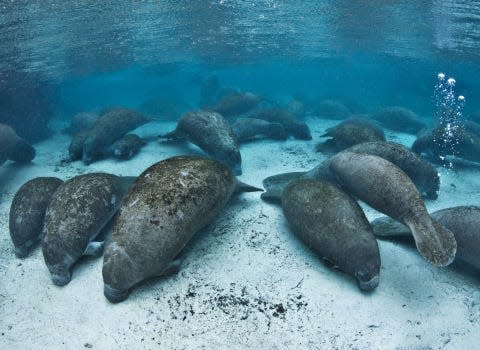Effort to increase protections for Florida's beloved manatees takes first steps

Federal authorities took the first step toward reclassifying Florida's beloved sea cow, the West Indian manatee, as an endangered species.
Manatees were removed from the endangered species list in 2017 and reclassified as a threatened species. The U.S. Fish and Wildlife Service announced Wednesday that the agency is opening a 90-day finding period to review additional scientific and commercial data and decide if there is enough reason to reclassify them as endangered once again.
Tuesday's action comes after a formal petition made by several environmental advocacy groups, including the Center for Biological Diversity, Harvard Animal Law & Police Clinic, Miami Waterkeeper and Save the Manatee Club, and a solo Puerto Rican engineer. The groups issued a joint statement in celebration of Wednesday's announcement.
More manatees: For manatees on Florida's west coast, red tide is a complicated, deadly nemesis
Also: 'Blood on their hands.' Advocates call for manatee's release from Mote Marine in Sarasota
The species may be determined to be endangered if it meets one or more of five factors: the destruction or threat of destruction of its habitat, overuse for commercial, recreational, scientific, or educational purposes, disease or predation concerns, the inadequacy of existing regulations, or other manmade factors.
According to the Center for Biological Diversity, the species has declined dramatically since 2017. The group points to pollution-fueled algae blooms and an ongoing mortality event they say approached 2,000 deaths in 2021 and 2022 combined. The center's Florida chapter is based out of St. Petersburg.
Florida Fish and Wildlife Commission records show a significant threat from human activity also plays a heavy hand in manatee mortality. So far in 2023, there have been 476 confirmed manatee deaths, including 77 killed by verified boat strikes, another 14 were attributed to other human factors.
An additional 77 deaths were confirmed as natural, 11 from cold stress, 77 were perinatal calves, 38 could not be determined, and another 182 were not necropsied.
“This finding by the Fish and Wildlife Service is a crucial step in manatees’ road to recovery,” said Ben Rankin, a legal fellow at the center. “Scientists have documented overwhelming threats to manatees in recent years, and it’s heartening the government is taking action to respond.”
There are two subspecies of West Indian manatee: the Florida manatee seen throughout U.S. waters, and the Antillean Manatee that lives along the Caribbean islands, Cuba, and south from the Mexico shore down to Brazil.
The species may be determined to be endangered if it meets one or more of five factors: the destruction or threat of destruction of its habitat, overuse for commercial, recreational, scientific, or educational purposes, disease or predation concerns, the inadequacy of existing regulations, or other manmade factors.
“The positive response is a welcome sign of hope for both subspecies of the West Indian manatee, the Antillean manatee and the Florida manatee, to once again thrive and inspire future generations,” said Frank S. González García, a Puerto Rican engineer advocating for protections for manatees. “The moment is ripe to focus on and revert growing negative impacts that harm and jeopardize manatees’ wellbeing and their chances to recover.”
This article originally appeared on Sarasota Herald-Tribune: Effort to return sea cows to endangered species list moves forward
